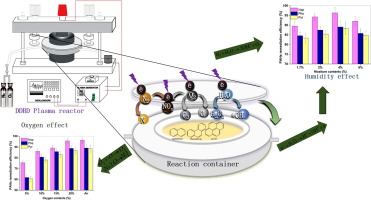Chemical Engineering Journal ( IF 13.3 ) Pub Date : 2020-03-24 , DOI: 10.1016/j.cej.2020.124858 Yawar Abbas , Wenjing Lu , Huixing Dai , Xindi Fu , Rong Ye , Hongtao Wang

|
A double dielectric barrier discharge (DDBD) plasma reactor was used for the remediation of simulated contaminated soil by a mixture of two, three and four rings PAHs i.e. naphthalene (Nap), phenanthrene (Phe) and pyrene (Pyr). Various influencing parameters such as peak-to-peak applied voltage, soil moisture, oxygen to nitrogen ratio (O2:N2) of carrier gas and soil depth in the reactor were investigated. The results illustrate that with an initial PAH concentration of 100 mgkg-1the remediation efficiency increased by 27-30% when the applied voltage was increased from 28 to 40 kV. When the moisture content had been raised from 1.7% to 4% the remediation efficiency of Nap, Phe and Pyr increased from 89.55, 84.51 and 83.36% to 96.32, 89.08 and 88.59% respectively. However, further increase in moisture content decreased the PAHs remediation efficiency. With increasing oxygen to nitrogen ratio, the remediation efficiency of PAHs increased up to 20%. Higher oxygen concentrations in DDBD reactor has beneficial effect due to the generation of increased oxygenated species such as ozone, atomic oxygen and nitrogen oxides in discharge zone. When the soil thickness in the reactor was increased from 1 mm to 3 mm - due to decreased penetration of active species into the deeper zone of the soil - the remediation efficiencies decreased by 10%. Compared to ozonation the treatment of PAHs in the DDBD reactor resulted in higher remediation efficiencies. This is due to the generation of more active species in case of DDBD plasma treatment. The study demonstrates that DDBD plasma is a promising technology for remediation of heavily contaminated sites of PAHs due to its high remediation efficiency and robustness.
中文翻译:

双电介质阻挡放电等离子体技术修复多环芳烃(PAHs)污染土壤:影响参数
双介电势垒放电(DDBD)等离子体反应器用于通过两个,三个和四个环PAH(即萘(Nap),菲(Phe)和pyr(Pyr))的混合物来修复模拟污染的土壤。研究了反应器中峰-峰施加电压,土壤湿度,载气氧氮比(O 2:N 2)和土壤深度等各种影响参数。结果表明,初始PAH浓度为100 mgkg -1当施加的电压从28 kV增加到40 kV时,修复效率提高了27-30%。当水分含量从1.7%提高到4%时,Nap,Phe和Pyr的修复效率分别从89.55、84.51和83.36%提高到96.32、89.08和88.59%。但是,进一步增加水分含量会降低PAHs的修复效率。随着氧氮比的提高,PAHs的修复效率提高了20%。DDBD反应器中较高的氧气浓度具有有益的作用,这是因为在放电区中生成了更多的含氧物质,例如臭氧,原子氧和氮氧化物。当反应器中的土壤厚度从1毫米增加到3毫米时-由于活性物质向土壤深层渗透的减少,修复效率降低了10%。与臭氧化相比,DDBD反应器中PAHs的处理导致更高的修复效率。这是由于在DDBD等离子体处理的情况下产生了更多的活性物种。这项研究表明,DDBD血浆具有很高的修复效率和耐用性,因此它是一种用于修复严重污染的PAHs的有前途的技术。











































 京公网安备 11010802027423号
京公网安备 11010802027423号